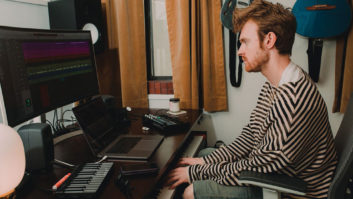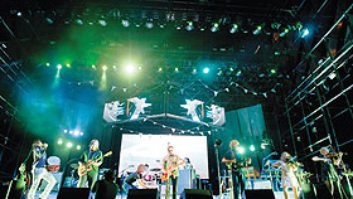
London, UK (March 13, 2024)—The world may be patiently waiting for the final season of Stranger Things on Netflix, but those who can’t get enough of the upside-down may want to head not to Hawkins, Indiana, but instead to London’s West End. A theatrical prequel, Stranger Things: The First Shadow, set in 1959, has been both scaring and enthralling audiences inside the Phoenix Theatre, thanks in part to a sound design by Paul Arditti with associate sound designers Rob Bettle (handling the system design) and Christopher Reid (developing the audio content).
“We knew from the outset that we needed to give the show the visceral power of the Netflix series,” Arditti explains. “We wanted to deliver incredible illusions, horror, and stage magic, backed up with a wall-to-wall sound and music score.”
In addition to using sounds from vintage electrical and electronic sources, Arditti and composer DJ Walde also employed ring modulators, tape echoes, oscillators, and theremins to craft space-age effects. Many of those elements come into play in “The Black Void,” he noted: “It’s our version of the silent, watery, black emptiness Eleven goes to when, either forcibly or voluntarily, she undergoes sensory deprivation. For me, the utter silence of this dimension is key to its weird power, but utter silence is neither exciting nor achievable in a theater, so we had to find ways of implying that silence through the use of low-frequency soundscape beds, moving water sounds, and curious echoes. We also bookended each visit to this reality with a loud and memorable, ripping ‘whoosh,’ so the audience knew where we were heading each time we went there.”
Hanoi’s Ho Guom Opera Expands Acoustic Options
Providing audio for the production is Stage Sound Services, which has in turn employed a sizable Meyer Sound system to surround the audience. The team provided specifications for Meyer Sound’s low-profile Ultra-X20, Ultra-X40, Ultra-X42, and UP-4slim loudspeakers. Arditti shared, “The Ultra-Xs sound like giants but look like near fills. They are super flexible—we use them in single point-source portrait orientation on the proscenium and also in landscape orientation in splays of two and three speakers above the pros.”
Meanwhile, UP-4slim ultra-compact installation loudspeakers are used for delays, front fills, and side fills. “They complement the Ultra-Xs perfectly, with that same crisp voicing and wide dispersion. They are also capable of very high SPLs without any apparent effort,” said Arditti.
Stage Sound Services has also provided the production with the first 2100-LFCs in the West End—a turn of events that met the audio team’s approval. “The 2100s are mind-blowing,” said Bettle. “I have never heard a sub that is so precise at delivering the sub-50Hz range. They offer unbelievable power and speed in a relatively small format.”





